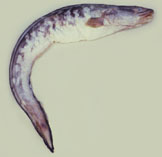| Family: |
Ophidiidae (Cusk-eels), subfamily: Ophidiinae |
| Max. size: |
200 cm SL (male/unsexed); max.weight: 25 kg; max. reported age: 46 years |
| Environment: |
bathydemersal; marine; depth range 22 - 1000 m, oceanodromous |
| Distribution: |
Southwest Pacific: southern Australia and around New Zealand. Southeast Pacific: Chile (Ref. 9068). Southwest Atlantic: Brazil (Ref. 4517). |
| Diagnosis: |
Dorsal spines (total): 0-0; Dorsal soft rays (total): 141-164; Anal spines: 0-0; Anal soft rays: 101-126; Vertebrae: 68-70. Body pinkish yellow, marbled with irregular reddish brown blotches dorsally (Ref. 27363). |
| Biology: |
Common species (Ref. 34024). Found between depths of 22 m (Ref. 58489) and 1000 m (Ref. 33848). Feed mainly on crustaceans such as Munida and scampi and also on fish. Also caught above the bottom when feeding on hoki (Macruronus novaezelandiae) during the hoki spawning season. Available all year round. Juveniles are found in shallower shelf waters (Ref. 6390). Oviparous, with oval pelagic eggs floating in a gelatinous mass (Ref. 205). Utilized fresh, frozen or smoked; can be fried and baked (Ref. 9988, 34024). |
| IUCN Red List Status: |
Vulnerable (VU); Date assessed: 04 March 2024 (A2bd) Ref. (130435)
|
| Threat to humans: |
harmless |
Source and more info: www.fishbase.org. For personal, classroom, and other internal use only. Not for publication.
